Print out the duty schedule. How to create your daily and weekly cleaning schedule
But they still require a more extensive explanation.
Let's first focus on daily and weekly recurring cases.
A cleaning schedule for your apartment will help you keep the peace and quiet in your home, and will also reduce the time used to complete this work if you stick to it.
If you think that organization and cleaning are in no way connected, you are mistaken. One directly depends on the other (and vice versa). If your house is organized, it will be much easier for you to clean it. You will feel comfortable in it and find it, if not perfect, then at least clean and tidy. Organization, on the other hand, allows us to identify places to store things and develop habits of putting things in these places. But at the same time, any solution to an organizational problem begins (and sometimes ends) with cleaning. And besides, even the most organized house needs to be cleaned, among other things, to keep things organized.
How to create a cleaning schedule for your home
Step #1: Consider what cleaning tasks your home needs to do daily and weekly
Our life goes on every day in a vicious circle. Clothes become dirty, they need to be washed, dried, ironed and put back in the closet. Similarly, with dishes, for example.
Therefore, we want to ensure that our home does not turn into a place where this cycle one day ceases to be closed. Baskets are filled to overflowing with dirty laundry, the sink is full of dirty dishes, there is only dust and dirt around.
Unfortunately, most of us can't afford to hire house helpers to do all the dirty work, and we have to make this whole wheel spin ourselves.
The cleaning schedule is cyclical, i.e. constantly and with a certain frequency recurring (daily, weekly, monthly, quarterly, every six months or a year).
Having a cleaning schedule in place and sticking to it is one of the best and most in a simple way make sure chores are done on time and the cycle doesn't stop.
Of course, not everything needs to be done every day. Therefore, you should have several cleaning lists:
- daily
- weekly
- monthly
- and a seasonal cleaning schedule (in the seasonal one, you can break things down into quarters, six months, or into those that need to be done once a year).
In order for you to be able to comply with the schedule drawn up by yourself, remember the most important rule - it must be realistic. You must clearly define what tasks should be in without fail performed on a daily and weekly basis. But at the same time You must be able to complete them. If you work full time, and schedule your daily task to mop the floors throughout the house, it's likely that your schedule will remain just plain paper. Therefore, think about what things are really necessary and possible to do daily, and which ones are enough to do once a week or even once a month (etc.)
If, nevertheless, in your opinion, in order to achieve the cleanliness of your home, you need to do more daily and weekly than you can, it's time to attract assistants and distribute some of the overwhelming responsibilities to other members of your family.
All houses and apartments differ from each other (in terms of area, number of rooms, their functional purpose), but most of them are still similar. Therefore, to schedule cleaning, I suggest you use the templates I have prepared:

Step #2: Create Two House Cleaning Schedules: Daily and Weekly
In order to more clearly understand how to correctly distribute daily and weekly tasks, I suggest that you consider several ready-made practical solutions.1. Weekly Fly Lady Cleaning Schedule
If you are not yet familiar with the fly lady system, you can familiarize yourself with it on the official English or Russian website.This is how the weekly cleaning schedule according to the Fly Lady system looks like (on the left are tasks that need to be performed once a week, on the right are tasks that are performed once a day throughout the week.
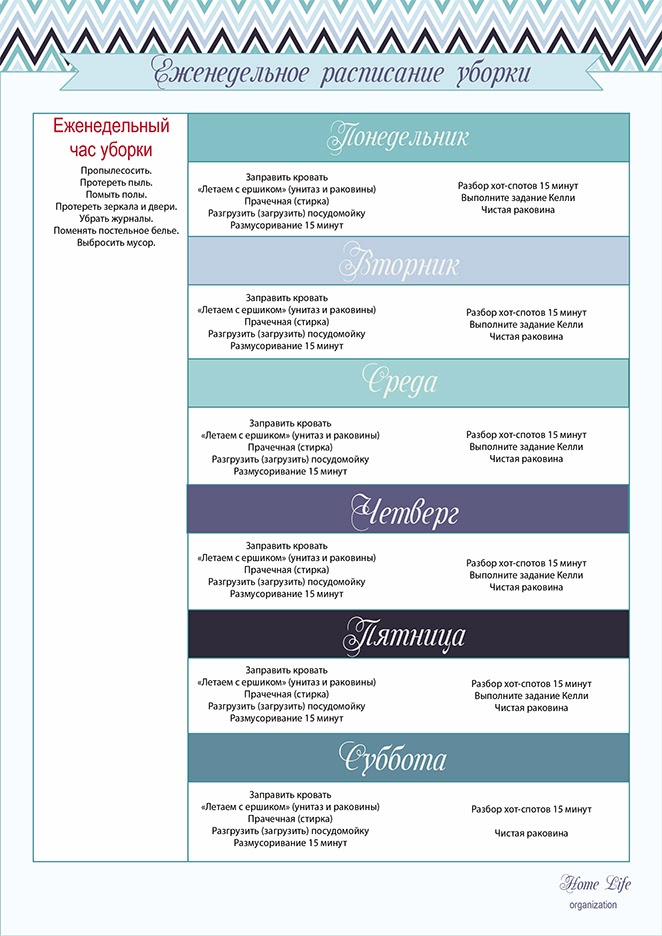
According to the fly lady system, you need to:
- disassemble hot spots (hot spots) where dirt, debris and things that are completely unnecessary there accumulate;
- refresh the toilet and sink;
- wipe surfaces in the kitchen (stove if necessary);
- complete Kelly's mission.
- vacuum the floors;
- wipe the dust;
- wipe mirrors and doors;
- remove magazines (well, apparently everything that gets on top in the wrong places);
- change bed linen;
- to throw out the trash.
Monthly household chores (in the fly lady system, these are mainly Kelly's tasks (mainly because seasonal and annual household chores are also added to them, which are suggested to be done for 15 minutes a day (wash the ventilation grate or radiator in the bathroom, etc.). ), that is, those things that we do only once a month:
- wipe the refrigerator
- wipe down the microwave
- wipe switches and sockets;
- wash skirting boards;
- polish furniture, etc.
These tasks in the fly lady system are divided into a month and are performed in each zone. In short, the whole apartment is divided into 5 zones, in accordance with 4 full weeks of the month + a few days at the beginning of the month of an incomplete week (if any). Everyone divides their house or apartment into zones in their own way, but most often everything is pretty similar.
"Zone 1: first few days of the month until next Sunday: entrance, hallway, corridor
Zone 2: first full week of the month: kitchen, dining room, pantry
Zone 3: second full week of the month: children's, bathroom
Zone 4: third full week of the month: bedroom, toilet
Zone 5: the last few days of the month from Monday to the 1st -living room, balcony"
But before you create your list of daily, weekly and monthly tasks in each zone, I recommend that you make a generally complete list of all possible things to do in your house for each zone (or room). Use the template: Cleaning schedule for rooms (zones) for the whole year. It will help you to fill it out. Take it as a basis and distribute what things you do daily, weekly or once a month. Seasonal cleaning and things that need to be done once every six months (for example, replace the filter in the kitchen hood or even once a year (for example, deep cleaning of carpets or dry cleaning of sofa upholstery).
 |
| photo: cleanmama.net |
I like the fly lady system for its versatility. It can be modified, customized and improved.
Such an analogue is, in my opinion, the variant of the weekly cleaning schedule from Becky, the author of the cleanmama.net blog, and I consider it the most successful. At least that's what I use. Below I will give examples of a few more, so you will have the opportunity to evaluate for yourself.
The main difference between this schedule and the fly system schedule is the distribution of the list of weekly recurring tasks performed in the fly system. According to the fly system, they are all performed on Monday at weekly cleaning hour. No matter how much I tried, but I don’t have enough time to do all these things, or on Mondays I’m exhausted by this ECHU (weekly cleaning hour) so that these Mondays have become not nice to me in principle. In my opinion ECHU on Mondays is possible only if you are a housewife. I would do this cleaning on the weekend, but (again:) I like the idea that on weekends you still need to relax and spend time with your family, do yourself and your hobbies. So I decided to look for alternatives and came across the cleanmama.net blog
With Becky, all these things that are done on the fly system on Monday are evenly distributed throughout the week. On Monday: we clean the sinks and toilets (according to the fly system, this should be done daily), on Tuesday we wipe the soap, on Wednesday we vacuum, on Thursday we clean the floor, on Friday we litter, on Saturday we change sheets and towels.
The following daily routines are also performed daily:
- wash
- ironing
- Wipe down all exposed surfaces
- clean floor (the floors are cleaned from what can fall on them, i.e. from everything superfluous that should not be on the floor. You don’t need to vacuum and wash the floors every day. This is just an analogue of hot-spot analysis in the fly lady system :)
If you liked Becky's Weekly Cleaning Schedule, you can print this schedule and use it for yourself:
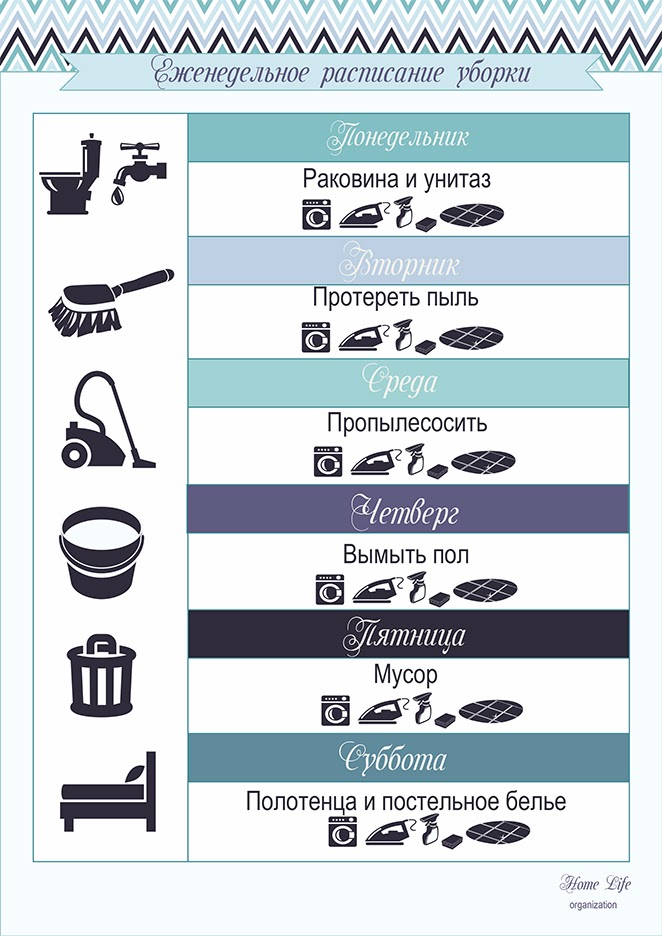
Also a very good cleaning schedule in my opinion and deserves our attention. The weekly chores are categorized primarily by the type of surface being cleaned, with repetitive routines performed daily and one additional chore added to them: vacuuming or mopping the floors. In addition, each case concerns only one area (kitchen or bathroom, for example).
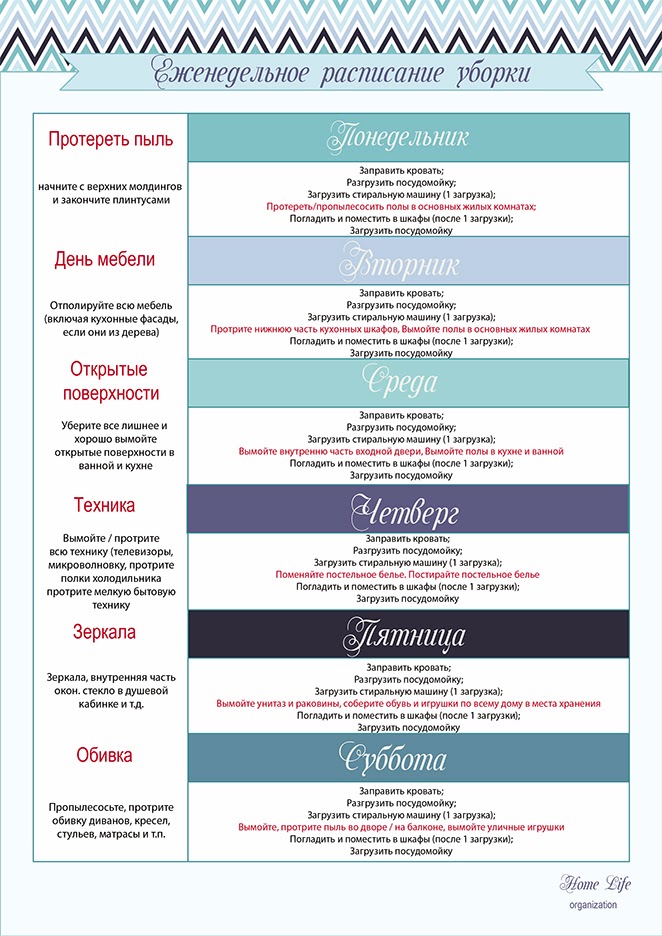

In this schedule, tasks performed once a week are distributed depending on the corresponding zone (room) of the house. It is very convenient and, unlike the fly system, you do not have to remember which zone you are working in this week. Monday is the kitchen and dining room, Tuesday is the living room, Wednesday is the parent's bedroom and bathroom, Thursday is dedicated to the children's bathroom, Friday is the children's room (and guest room). I added a children's room to the original schedule, because. in our country, these are more like children's rooms than guest rooms. That is, if in all previous schedules we simultaneously vacuum the entire apartment on some day, in this schedule it is proposed to focus every day on a specific area of \u200b\u200bour house. Every day, approximately the same routines are performed as in all other schedules.
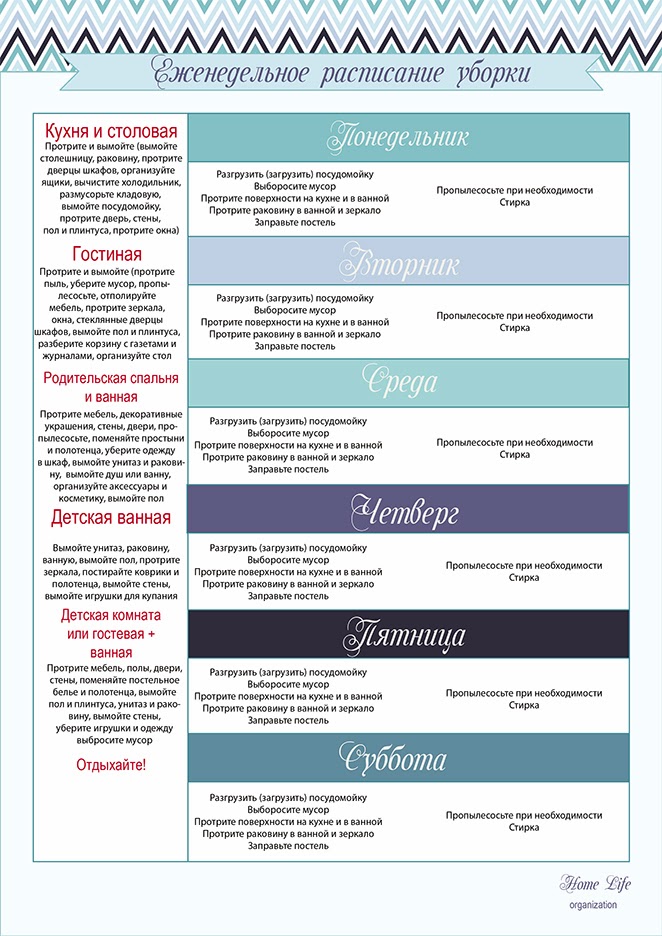
It seems to me that illustrative examples give more understanding of how to separate daily tasks from weekly (monthly or yearly). So now you are ready to start creating your own daily and weekly cleaning schedule. I suggest you download the following template for this:

A few more compilation tips daily to-do list:
Your weekly cleaning schedule is a list of repetitive tasks that you must do daily (or once a week) enough to keep your house clean. Try to keep this list as simple as possible.
Be realistic and after making a list, take another look at how long your daily activities will take. This list should not be too long and take more time than you can spend on it, because in addition to daily and weekly tasks, you should spend time doing the most common (including personal) routines.
You can also break up your schedule and determine which list items you will do in the morning, which in the afternoon (if you are not working), and which in the evening.
A few compilation tips weekly cleaning schedule:
As I said above, you need to make a list of things that you will only do once a week. I recommend dividing their performance evenly over each day of the week and spending 15-20 minutes a day doing such a thing. You can start from the type of activity or room (see more details above) or even combine them, as you see fit.

On a daily basis, once you have completed your daily routines, you can start doing one or more weekly repetitive tasks.
Only you can decide how to distribute them so that they fit into your life schedule, and don't forget to bring helpers in the process of cleaning, because almost most of our energy is spent on cleaning our house. Be realistic by assigning weekly recurring tasks.
Step #3: Build the Habit of Keeping Your Daily and Weekly Cleaning Schedules
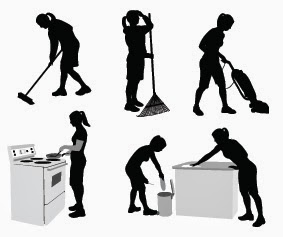
Once you have created what you think is a good cleaning schedule for your home, the next step is to force yourself to get used to it and stick to it. I say force, because, unfortunately, it really is. Give yourself at least one month to do this, and believe me, it will be easier later on, because following this schedule will become a habit for you. But at first it will be very difficult.
How to force, you ask? So you've made your cleaning schedule. Print it out. But do not put it in your home organizer, but hang it as a reminder to yourself in the most prominent place. It could be your home command center, your desktop, or any other place you pay attention to all the time. Use this schedule to remind yourself what task you have to complete today. An equally important post-execution task is the execution control process.
For control, fill out and hang in a conspicuous place, or even better, just print and attach to a tablet that you can carry with you throughout the house checklist.
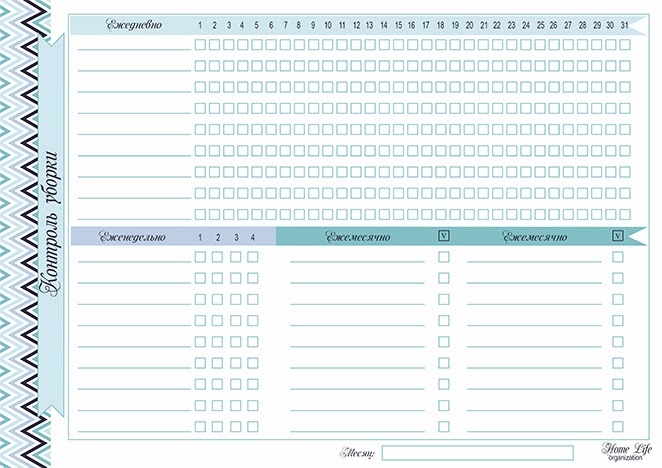
If you think you don't need it, you are wrong. At the very least, try to use it for a few months until you get used to it. Perhaps in the future you will simply understand how convenient it is. And how nice it is to tick off the list after completing the next task!
If you declutter and organize your home regularly, following this schedule won't be too much of a hassle for you. But if your house is not yet organized and cleaned, it is likely that there will be much more cleaning than we would like. So don't expect results right away. give yourself time , engage in regular littering and organization of your home and, believe me, it will become much easier for you to solve cleaning problems than it seems at first. The main thing is to follow the schedule regularly , regularly decluttering and organizing the house.
But be realistic and revise your schedule as needed if you feel it's too much for you. It is impossible that maintaining cleanliness in your house turns into flour and hard labor for you.
Remember that your cleaning schedule should be consistent with your typical, habitual routine. Try to make your schedule as flexible as possible, and try to make the most of it.
Finally, don't be afraid to tweak your schedule if it doesn't fit your needs. Work with your schedule for a few weeks, maybe you will realize that you were too harsh and demanding and the schedule you compiled simply cannot fit into the time you have available and you have failed. Or, on the contrary, you were too modest and relaxed, and your schedule cannot provide the minimum purity that you wanted to achieve. Don't despair, try changing your schedule to better suit your needs and time constraints and try again.
Remember, however perfect your schedule may be, it is ultimately only a tool to help you clean up, not the foundation of your bondage. If you feel like this is happening, rearrange the schedule again so that it can fit your needs, and most importantly, your abilities.
You will need
- - the decision of the trade union;
- - labor contract;
- - internal regulations;
- - chart form;
- - pen.
Instruction
Make a watchman schedule for each reporting period. Consider one month of work as the reporting period. When drawing up the schedule, take into account the opinion of the trade union committee and the employee himself.
When drawing up the schedule, consider article 94 of the Labor Code of the Russian Federation. At the same time, if in your organization the calculation of wages is made by summing up the working time for the reporting period, then you have the right to draw up any schedule. For example, each watchman can work for 24 hours, but at the same time, after the work shift, there must be at least 48 hours of rest. For continuous protection of the enterprise, you will have to take 3 watchmen.
If you set a work schedule of 24 hours of work and 72 hours of rest, then you will have to accept 4 watchmen.
Having set a schedule of 8 hours, that is, a three-shift work procedure, 3 watchmen will guard the enterprise for a day of work. Each watchman, according to labor law, can work no more than 6 days a week, that is, you will have to hire 1 or 2 more shift workers.
You can set a 12-hour work shift. According to the Labor Code, with a 12-hour working day, working time cannot exceed 40 hours per week. That is, the legislator allows the employer to apply any work schedule, the main thing is that work alternates with the prescribed rest, the duration of which cannot be less than 42 hours a week (Article 110 of the Labor Code of the Russian Federation).
Installed schedule ohm break for rest and eating in duration should be from half an hour to two hours. Calculate the normative number of working hours per month in accordance with the Production calendar for the current year. In the event that the actual number of them exceeds the norm, consider the hours of processing as overtime at the end of the working period.
Related videos
Article 103, part 3 of the Labor Code of the Russian Federation establishes the mandatory coordination of the developed shift schedule with the representative body of employees. Usually, this is a committee of trade unions. If it is not at your enterprise, then you need to create such a body - the Council of Workers.
Sources:
- shift schedule is like in 2017
In some enterprises with a continuous production cycle or those whose activities are related to the round-the-clock provision of services, there is a need for personnel to work on shifts. This is allowed and regulated by Article 103 of the Labor Code of the Russian Federation. According to the law, shift work of personnel can only be carried out in accordance with schedule shifts, agreed with the representative body of employees.

Instruction
If you have a need to change the mode of operation of the enterprise and transfer it to shift work, then you need to legally execute everything competently, since this is associated with a change in working conditions. In this case, changes are made to the employment contract, this is done with the agreement of the parties. This means that it is necessary to coordinate the changes with the committee of trade unions or any other representative body of employees.
According to Article 103 of the Labor Code of the Russian Federation, the number of daily work shifts can be set to 2, 3 or 4. Accordingly, their duration can be 12, 8 or 6 hours. Shifts lasting 24 hours are contrary to the Labor Code of the Russian Federation. Depending on the specifics of the technological processes at your enterprise, determine how long the shift will be optimal for you. Immediately set the accounting period, at the end of which the balance of working hours and the calculation of hours of work will be ensured - week, month, quarter, year.
In the schedule, be sure to provide for the procedure for the actions of employees at the end and beginning of the shift, the procedure for its transfer and the actions of the employee in case of non-appearance or lateness of his shift.
When drawing up a schedule, it is necessary to take into account several mandatory parameters, the effect of which is enshrined in the Labor Code of the Russian Federation. So, the duration of the weekly uninterrupted rest of the employee must be at least 42 hours, and the duration of rest between two consecutive workers shifts and must be at least twice the duration of the shift.
Please note that, except for the cases specified in Article 96 of the Labor Code of the Russian Federation, the duration of the night shift is set 1 hour less. On pre-holiday days, this rule also applies, but if the production technology does not allow such a reduction, the employee has the right to additional rest time or additional payment as for overtime work.
Schedule the length of rest and lunch breaks for each shift. Determine, taking into account its number of actual working hoursattributable to each employee per month. Calculate the working time standard in accordance with the production calendar for the current year. If there is a fact of processing, then all overtime hours must be taken into account at the end of the accounting period and paid as overtime.
A watchman is a hired employee whose profession belongs to the general classifier and has nothing to do with security guards who work with a license that allows them to carry out armed guarding of the enterprise. You can set any work schedule for the watchman, it depends on the conditions specified in the employment contract, and make payment according to tariff categories 016-94.

You will need
- - calculator or 1C program;
- - schedule.
Instruction
Specify the salary of the watchman when drawing up an employment contract. In accordance with the resolution of the State Committee for Labor 58 / 3-102 and the Ministry of Labor of the Russian Federation 15A, you can set a salary or an hourly rate for a watchman.
You can set the watchman's work schedule to 24-hour, 12-hour or 8-hour. Calculate payroll in accordance with general rules based on the total number of hours worked per month.
If the watchman works in night shifts, which, in accordance with the Labor Code of the Russian Federation, begin at 22:00 and end at 6:00, then add 20% to the total earnings, unless otherwise specified in the internal legal acts enterprises.
For work on all-Russian holidays, make double payment, regardless of the watchman's work schedule. If the employee expressed a written desire to receive an additional day off instead of double payment, then pay for work on holidays in a single amount.
For example, if a watchman receives an hourly rate of 100 rubles for one hour of work, then calculate separately all working hours for night shifts, multiply by 100 and 20%. Separately calculate the payment for day shifts. If the total calculation of working hours exceeded the general norm in a working month, based on the number of working days in a given month, multiplied by 8, then multiply all hours of processing by 200 rubles.
Very popular and necessary is the visualization of statistical and any other numerical data. In fact, nothing can represent a numerical sequence so clearly and gracefully as a relevant and timely schedule. Charts literally enliven a “dry” table, making it understandable, clear and structured. This article will discuss how to build a graph in the Word text editor of all versions.
Graphing in Word 2003, 2007, 2010, 2013
Despite the somewhat more than solid age of these builds, they have all the tools for visualizing numerical data. Suppose you have compiled a simple table in Word, and, in order not to be unfounded, you decide to display the data from it in the form of a visual graph or chart. How to do it?
There are quite a few other items in the options menu, so we suggest that you familiarize yourself with them.
In all these versions of Word, the principle of constructing a diagram is absolutely similar, and you will quickly adapt to this mechanic.
How to build a graph in Word 2016?
In the most up-to-date version of the Word text editor, the tools for visualizing numerical data in the form of graphical charts have been significantly improved and modified. Angular and slightly nondescript, taking into account modern technological trends and fashion trends, charts have been replaced by catchy stylish and smooth lines of axes and trends. Now the graphs look much more elegant and impressive, and have a very representative character.

Interestingly, now the charts are not built exactly according to tabular data. Now the Word engine builds a proportion according to the information entered in the fields of the table and creates a general graph based on the accumulated information. This must be taken into account when aggregating data. Further, the principle of setting up the axes, the legend and the visual presentation of the chart is similar to what we saw in earlier versions of the engine. It is important to note that for the finalized presentation of the graph, the data will have to be slightly adjusted, after which they will take the final form that meets your requirements.
As you will soon see, there is nothing complicated and extraordinary in the method of creating graphs. For almost 15 years, the principle of generating diagrams in Word has not changed at all, so having understood just one version of the text editor, you can easily master this mechanic in any other release of this software product.
